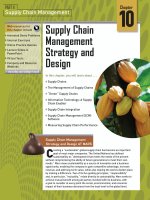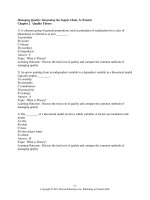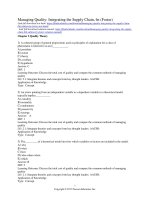Lecture Operations management: Creating value along the supply chain (Canadian edition) - Chapter 12
Bạn đang xem bản rút gọn của tài liệu. Xem và tải ngay bản đầy đủ của tài liệu tại đây (3.03 MB, 70 trang )
OPERATIONS MANAGEMENT:
Creating Value Along the Supply Chain,
Canadian Edition
Robert S. Russell, Bernard W. Taylor III, Ignacio Castillo, Navneet Vidyarthi
§
CHAPTER 12
Forecasting
1
§
Learning Objectives
Strategic Role of Forecasting in Supply Chain
Management
Components of Forecasting Demand
Time Series Methods
Forecast Accuracy
Time Series Forecasting Using Excel
Regression Methods
12-2
§
Forecasting
Predicting the future
Qualitative forecast methods
subjective
Quantitative forecast methods
based on mathematical formulas
12-3
§
Supply Chain Management
Accurate forecasting determines inventory levels in
the supply chain
Continuous replenishment
supplier & customer share continuously updated data
typically managed by the supplier
reduces inventory for the company
speeds customer delivery
Variations of continuous replenishment
quick response
JIT (just-in-time)
VMI (vendor-managed inventory)
stockless inventory
12-4
§
The Effect of Inaccurate Forecasting
12-5
§
Forecasting
Quality Management
Accurately forecasting customer demand is a key to
providing good quality service
Strategic Planning
Successful strategic planning requires accurate forecasts
of future products and markets
12-6
§
Types of Forecasting Methods
Depend on
time frame
demand behavior
causes of behavior
12-7
§
Time Frame
Indicates how far into the future is forecast
Short- to mid-range forecast
•
•
typically encompasses the immediate future
daily up to two years
Long-range forecast
•
usually encompasses a period of time longer than two years
12-8
§
Demand Behavior
Trend
a gradual, long-term up or down movement of demand
Random variations
movements in demand that do not follow a pattern
Cycle
an up-and-down repetitive movement in demand
Seasonal pattern
an up-and-down repetitive movement in demand
occurring periodically
12-9
§
Demand
Demand
Forms of Forecast Movement
Random
movement
Time
(b) Cycle
Demand
Demand
Time
(a) Trend
Time
(c) Seasonal pattern
Time
(d) Trend with seasonal pattern
12-10
§
Forecasting Methods
Time series
statistical techniques that use historical demand data to
predict future demand
Regression methods
attempt to develop a mathematical relationship between
demand and factors that cause its behavior
Qualitative
use management judgment, expertise, and opinion to
predict future demand
12-11
§
Qualitative Methods
Management, marketing, purchasing, and
engineering are sources for internal qualitative
forecasts
Delphi method
involves soliciting forecasts about technological advances
from experts
12-12
§
Forecasting Process
Time Series
Assume that what has occurred in the past will
continue to occur in the future
Relate the forecast to only one factor - time
Include
moving average
exponential smoothing
linear trend line
12-14
§
Moving Average
Naive forecast
demand in current period is used as next period’s
forecast
Simple moving average
uses average demand for a fixed sequence of periods
stable demand with no pronounced behavioral patterns
Weighted moving average
weights are assigned to most recent data
12-15
§
Moving Average: Naïve Approach
12-16
§
Simple Moving Average
12-17
§
3-month Simple Moving Average
12-18
§
5-month Simple Moving Average
12-19
§
Smoothing Effects
12-20
§
Weighted Moving Average
Adjusts moving average method to more closely
reflect data fluctuations
12-21
§
Weighted Moving Average Example
12-22
§
Exponential Smoothing
Averaging method
Weights most recent data more strongly
Reacts more to recent changes
Widely used, accurate method
12-23
§
Exponential Smoothing
12-24
§
Effect of Smoothing Constant
12-25
§









